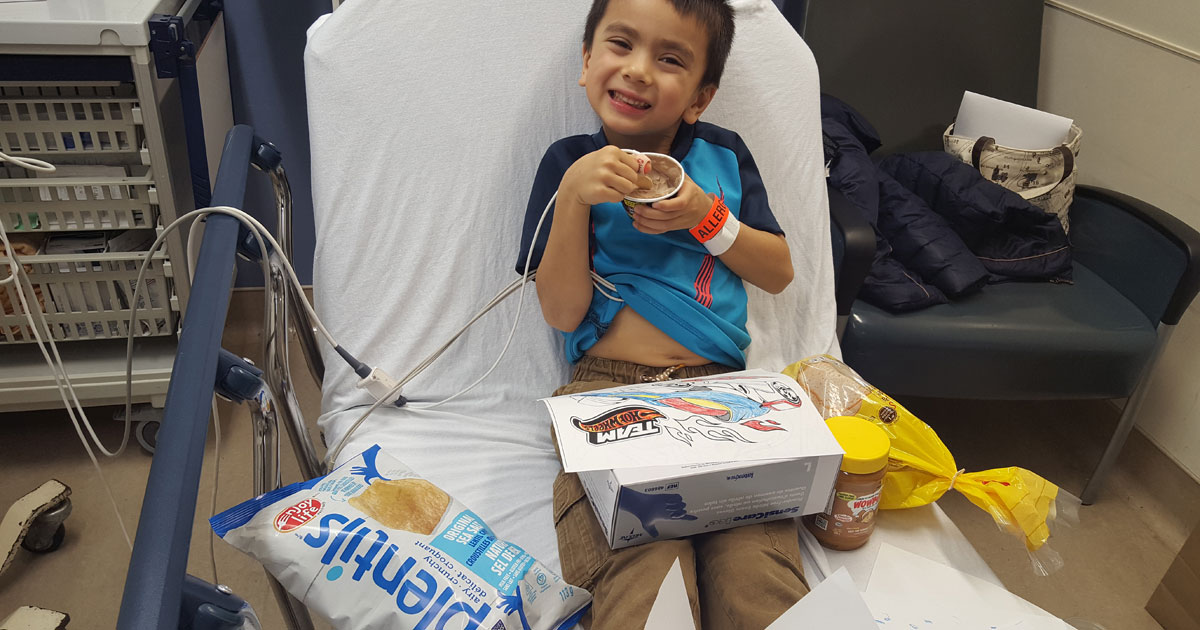2017 was a significant year for our family, with respect to food allergies in particular. We learned through new experiences, endured multiple food challenges with a few false positives, survived a couple of pretty scary reactions, and are ending the year with a new vision and purpose to carry us into the future years.
My 2017 recap involves 5 life changing and eye opening events. Some of the events were good, some were scary, and I’m ever grateful that none of them were tragic. That fact alone makes 2017 another beautiful year to celebrate.
1. One Fish, Two Fish, Red Fish, Blue Fish
We discovered that my youngest son was allergic to fish when he broke out in full body hives after a taste of salmon when he was a baby. Early this year, after skin prick tests, blood tests and discussion with our allergist, we thought that there might be a good chance that he could tolerate white fleshed fish (cod, halibut and haddock) so we decided to do a food challenge. The food challenge went well and we were cleared to feed our son cod fish at least three times a week in order to keep my son desensitized. Yay! Good news, right?
This might be the perfect time to mention that we’ve had many many many failed food challenges in the past. So when we “passed” the cod challenge I was unsure, but I allowed myself to get excited. In fact, I was thrilled to be able to serve fish to my family without any stress and I quickly found many cod recipes to try.
But the food allergy gods had different plans for us … During the first few cod meals, my baby boy ate well, but towards the end of the second meal he began to push the fish away. He was 18 months old at the time, so I didn’t think much of it, but the next time I served cod to him, he spit it out immediately and developed hives. A follow up skin test and blood test confirmed that in this process he became sensitized to cod fish. (facepalm.)
In the end, nothing had really changed. We were temporarily given some false hope, which was the most painful part of this. I allowed myself a short mourning period to say goodbye to what could’ve been, then I left it behind. I had no choice. Whether it’s one fish, two fish, red fish or blue fish, my son can’t eat it.
2. Exercise-Induced Anaphylaxis is a thing
Food challenges are an excellent way to definitively diagnose an allergy, and I only participate when I feel the chances of failing are minimal. That said, my eldest son has had many failed food challenges, and we unfortunately had to add another one to his list this year.
My son’s wheat allergy was always a mysterious one for us. We originally thought it was an intolerance because it caused his eczema to flare as a baby, but as he got older his reactions were more pronounced and clearly hives. His skin tests to wheat were always borderline, but blood tests confirmed the allergy. We avoided wheat, but foolishly believed it was one of his less serious allergies.
This year my son’s antibody levels for wheat were low enough that our allergist thought it would be possible to successfully challenge. We were hyped about the possibility of taking something off my son’s allergy list. We had a long discussion with our 6 year old son about the food challenge and explained the risk of having a reaction, and why the doctor believed he might pass the challenge. We also talked about the idea of him administering his own Epipen if it was needed. He agreed to do it, and went with me to buy the pasta and helped me prepare it on the morning of the test. I wanted him to own his allergy, and he was phenomenal.
It was an uneventful challenge, and after eating a bowl of wheat pasta and 3 hours at the office, he was free to go home. We were instructed to refrain from eating wheat for 24 hours and watch for any signs of delayed reactions, but if everything was normal he would be officially a wheat eater.
After a long day of sitting in a doctor’s office, my son was happy to attend his sports class after the challenge. He participated for the full hour, but when they were dismissed he walked to me and told me that his throat was hurting and he was having a hard time breathing. I lifted his shirt and saw hives all over his torso. Within a few minutes he told me he couldn’t breathe, so we decided to use the Epipen. We had already talked about him administering the Epipen himself, so I reminded him that he was going to do it, and walked him through every step slowly. He sat down, took out his Epipen and removed the blue safety with trembling fingers, and then placed the Epipen on his thigh, pushed and we counted together. Within seconds he felt normal again. It was magical. No, it was better than magic … it was science and technology at it’s best. Thank you epinephrine!!! You saved my son again.
We did the full ambulance and hospital song and dance as outlined in our emergency plan, and called our allergist the next morning. It turns out that rigorous exercise can sometimes induce anaphylaxis with the ingestion of certain foods (as if I don’t have enough to worry about), and wheat is a common culprit. If you’re interested in learning more, Anaphylaxis UK has a thorough fact sheet on Exercise-Induced Anaphylaxis.

Our “passed” food challenge was actually a “fail,” but I look back on that day as a true win. My 6 year old son talks about that day with great pride. He learned that he has the ability to help himself during an allergic emergency, and the importance of having his Epipen with him at all times was reinforced. We were also lucky to have been brought to SickKids hospital where they have a specialty food store that sells wheat-free, dairy-free, egg-free and nut-free bread and ice cream. We had a wonderful picnic at the hospital, full of delicious and allergy-friendly foods. Having access to delicious food allowed him to feel confident that he could find alternative allergy-friendly options for anything he wanted to eat. This is something that I want to be true for him in his lifetime. This is something that I will work endlessly to achieve.
3. The Mystery Reaction
A few months ago we were at a family dinner, and my youngest son who had confirmed allergies to eggs and fish took a bite from a bread stick while I had my back turned. This was of course a night that my husband was not there. I panicked a little, because I didn’t know the bread stick ingredients, but I quickly verified that his allergens were not present.
Within seconds my toddler started to get hives and his lips quickly ballooned. If you’ve ever been put in the position where you’ve had to decide whether or not to use the Epipen, you’ll be able to appreciate my internal debate. I know that the rule of thumb is with known ingestion of an allergen and when two systems are affected in an allergic reaction, you need to “Epi first and Epi fast.” Skin hives and swelling of mouth were two systems, and he had eaten a foreign food, so it should’ve been a no brainer, but I still hesitated. I don’t know if I was hoping that the symptoms would subside, or if I didn’t want to disrupt my family gathering, or if the idea of going to the hospital for 4 to 6 hours of surveillance was a deterrent, but my initial instinct was to wait and watch. It might have been a minute or just a few seconds, but I considered how young and small he was and how quickly his lips became swollen, and decided that this was not the type of reaction that I could afford to wait and watch. I used the Epipen on my 2 year old son, called an ambulance and spent the night at the hospital.
To this day, we still don’t know what caused this severe reaction, and I will never know what the reaction might have been if I didn’t use the Epipen. I don’t want or need to know this. The one thing I am sure of is that my son is healthy and thriving, I have no regrets about using the Epipen, and am proud of myself for taking action.
4. Learning Early About Peanut
With the fish allergy recurrence and the mystery reaction, I had a new found mission to “prevent” my youngest son from developing a peanut allergy as well. The results of the LEAP study were released just as he was born, and I followed the medical advice to introduce peanut early to his diet at regular intervals.
Since my eldest son has a severe allergy to peanut and our family generally doesn’t consume his allergens in our home, I decided that the best way to give peanut to my other children was by giving them scoops of peanut butter, followed by a thorough wipe down so they couldn’t leave any traces of peanut on the toys or furniture.
We kept this up regularly for my baby boy for about a year. At the beginning of the summer we moved and got extremely busy, so I skipped our regular regime for a few weeks. When I reintroduced peanut butter in the fall, he broke out in hives all over his face and torso shortly after eating. (facepalm)
Our allergist confirmed a new sensitization to peanut. I felt frustrated, angry and mostly defeated. I did everything I was “supposed” to do to prevent my son’s peanut allergy, yet he still developed one. I needed to make peace with this, so started to read more about the LEAP study and noted that with his egg allergy, eczema and the negligible size of his skin prick test, he would’ve fallen into the study cohort where 4.3% of kids still ended up with an allergy to peanut, not including the kids that dropped out of the study. While the LEAP study shows that introducing peanut early can reduce the incidence of peanut allergy in a large majority of the population, some kids still end up with peanut allergies, even under optimal conditions. Sometimes it really is just up to the food allergy gods.
5. Travelling with food allergies is fun
I’m ending my 2017 review on a high note. This year we decided to take a family vacation to Mexico, and successfully avoided 7 of the top 8 allergens while eating well and experiencing a new culture. We rented a condo, went grocery shopping and cooked all of our own food. This was a life changing and eye opening experience for all of us.

I always wanted to believe that food allergies would not limit our lives, and this trip helped reinforce that. It also gave my children confidence to know that with a little bit of extra planning and effort, similar to the way we live our daily lives at home, we could live and eat safely anywhere in the world.
Moving forward from 2017
As I look back on 2017, it feels like the kind of year one ends by pushing a reset button.
This year was full of changes and rich lessons learned, and the most important thing is that my children are healthy, happy and thriving. We still live with multiple food allergies, and we are not alone. As our children get older, we’re becoming more and more aware of the importance and the positive impact that eating out safely at restaurants can bring to the lives of people with food allergies.
The lessons from my past, my previous careers, my food allergy advocacy and all of the stories I’ve heard from my friends that live with food allergies have all led me to focus on the future to help create a safer world with more eating options for families with food allergies. I’ve embarked on an exciting new project that I will share more details about in a few weeks, but the future looks bright and delicious!
I wish you and your families a safe 2018 full of love, laughter and continuous learning!! Happy New Year!

